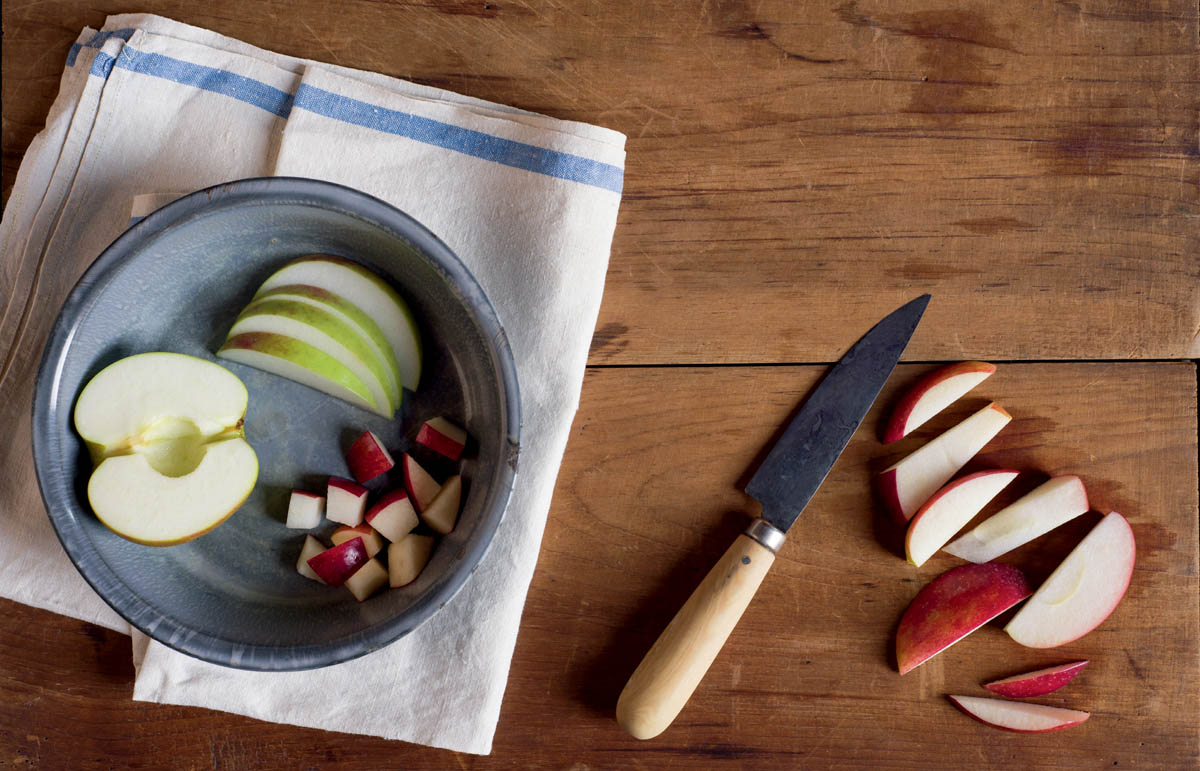
Man has been munching on apples for about 750,000 years, ever since the food gatherers of early Paleolithic times discovered sour, wild crab apples growing in the forests in Kazakhstan, in central Asia. Botanists now believe that this region holds the key to the genetic origins of the apples we enjoy today.

When U.S. botanists visited Kazakhstan in 1989, they found large stands of ancient apple trees — trees that were 300 years old, 50 feet tall, and bearing large, red apples. These trees of Malus sieversii, the wild species now believed to be the parent of all domesticated apples, were discovered in 1929 by Russian botanist Nikolai I. Vavilov.
Unfortunately, Vavilov’s work in genetics led to his imprisonment during the Stalin era. He died in prison in 1943. His wonderful discovery was finally announced to the rest of the world by a former student and coworker of Vavilov’s, who, at the age of 80, felt the need to pass along the knowledge before it was too late to save the forests of ancient apple trees.
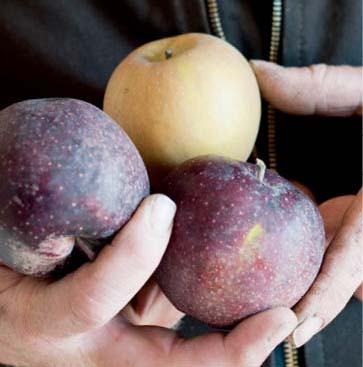
The carbonized remains of apples unearthed in Asia Minor indicate that Neolithic farmers were cultivating apples around 8,000 years ago. Later, apples were carried as transportable food by migrating cultures. It is speculated that somewhere along the way M. sieversii hybridized with M. orientalis and M. sylvestris, two wild species producing small and very sour green apples.
There is recorded evidence from 1300 BCE of apple orchards being planted by the Egyptians along the Nile Delta. The Greeks learned grafting techniques around 800 BCE, and by 200 BCE the Romans were planting apple orchards in Britain.
Colonists arriving in America found only four varieties of wild crab apples. However, the French, Dutch, German, and English all brought seeds from their homelands, and it wasn’t long before apple trees were growing outside their rustic dwellings. The English colonists were the first to bring apple tree scions (shoots) to North America.
The first American orchard was planted in Boston in 1625 by William Blaxton, an English preacher. A few years later, orchards were established in the same area by John Winthrop and John Endicott, governors of the Bay Colony settlement.
In 1647, Peter Stuyvesant, governor of New Amsterdam (now New York), planted the first Dutch apple trees on his farm, the Bouwerie. The first commercial orchard was planted in Flushing, New York, in 1730.
Thousands of varieties of apple trees evolved during the eighteenth and nineteenth centuries when colonial farmers decided to plant apple seeds instead of acquiring young tree scions arriving from England and continental Europe. As the colonists moved from the Atlantic coast westward, they planted apple seeds along the way.
Favorably influenced by moderately cold winters, the colonists’ apple crops flourished in the northern regions. Most apple tree varieties require from 1,000 to 1,500 hours of chilly temperatures before they will begin blossom growth in the spring. And the apples, just like autumn leaves, need the perfect marriage of temperatures — the warm, sunny days and cool nights that occur in September and October — to show off their best qualities.
On discovering the ancient wild apple groves in central Asia, Nikolai Vavilov rejoiced:
“All around the city one could see a vast expanse of wild apples covering the foothills. One could see with his own eyes that this beautiful site was the origin of the cultivated apple.”
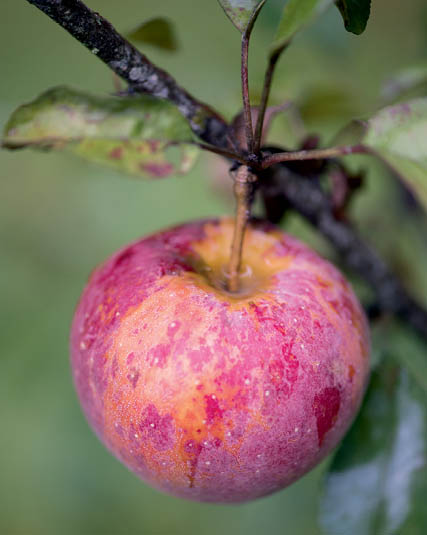
Cultivated throughout the United States, apples are grown for commercial production in 36 states. The main apple-growing regions are Washington, New York, Michigan, Pennsylvania, California, and Virginia. These six states produce most of the country’s annual apple crop, which totaled 259,248 million bushels in 2013. About one-third of the annual U.S. apple crop is processed into juice and canned, frozen, and dehydrated products. The average American eats 50.4 pounds of apples a year. It’s not only their year-round availability that makes apples so desirable in the United States; there are a host of other reasons why America loves apples:
When Eve was tempted by the serpent in the Garden of Eden to go against God’s wishes and to take what was forbidden “of the fruit of the tree which is in the middle of the garden,” she “saw that the tree was good for food, and that it was pleasant to the eyes, and a tree to be desired to make one wise.” No doubt she was also quite taken by the shape, color, and smell of this “fruit of the gods.”
Imagine yourself picking up an apple for the very first time. Turn it around in your hand. If it’s one of the russet apples, it will feel rough and dry, not at all like a red-on-yellow Empire with its satiny smooth and tender skin. Hold it to your nose and breathe deeply. The smooth-skinned Empire will have a delicate smell that is difficult to detect beneath its smooth and slightly oily skin. The rough skin of a ripe russet, on the other hand, will exude a tantalizing fragrance.
Most of the perfume cells are concentrated in the skin of an apple. As the apple ripens, the cells give off a stronger aroma. That is why applesauce is most flavorful when made from apples with the skin left on and the best cider is made from the aromatic, tough-skinned russets.
Rosy pink applesauce gets its color from the flesh, not from the skin — unless the skin has been puréed with the flesh to become an integral part of the sauce. The pigments trapped in the skin cells are not released during cooking, crushing, or pressing because those color cells are impossible to break.
Apple trees not only have taken the fancy of gods and mortals, they attract more than 30 species of birds and a variety of four-legged animals. There are birds that love to nest in the spreading branches. Many birds and beasts feast on the buds, bark, and leaves. The ripe, fallen apples are favored by porcupines, skunks, fox, and deer. Opossums, raccoons, and bears all climb the limbs to get at apple-laden branches.
Although hundreds of varieties of apples are grown in the United States, only 20 or so best sellers are cultivated in the major commercial orchards. Most commercial apples are chosen not for their wonderful taste but for their bountiful harvest; their suitability to mass planting, shipping, and long storage; and their resistance to diseases. Breeders, however, are constantly working to produce new hybrids that are sweet-tart with crisp and juicy flesh and are as wonderful for eating out of hand as they are for cooking. And, of course, the trees should retain all the qualities that make them a viable commercial enterprise.
The orchards are invaded by armies of apple pickers as early as July, but it is not until the cooler temperatures of September have touched this “fruit of immortality,” as it was once called, that an apple takes on those crisp and crunchy qualities so important to orchardists and apple lovers. It is in autumn that a bite into a fresh-picked apple becomes a memorable experience; the apple spurts juice that is honey-sweet and yet also spicily tart, and the flesh is so fragrantly mellow.
After December, these fall beauties come to us from controlled storage — somewhere between 32 and 36°F. This controlled atmosphere helps maintain the crisp qualities of the fall-harvested apples for several months. Today, shoppers find that a reasonable selection of apples is available well after the last of the fresh harvest disappears into cold storage. From January through June, most of us can find such good keepers as Pink Lady (Cripps Pink), Braeburn, Fuji, Gala, Golden Delicious, Granny Smith, Idared, McIntosh, Red Delicious, and Rome Beauty. In fact, Gala, Granny Smith, Golden Delicious, and Red Delicious are now available to us year-round from different hemispheres.
Detailed descriptions of apple varieties can be found in chapter 8.
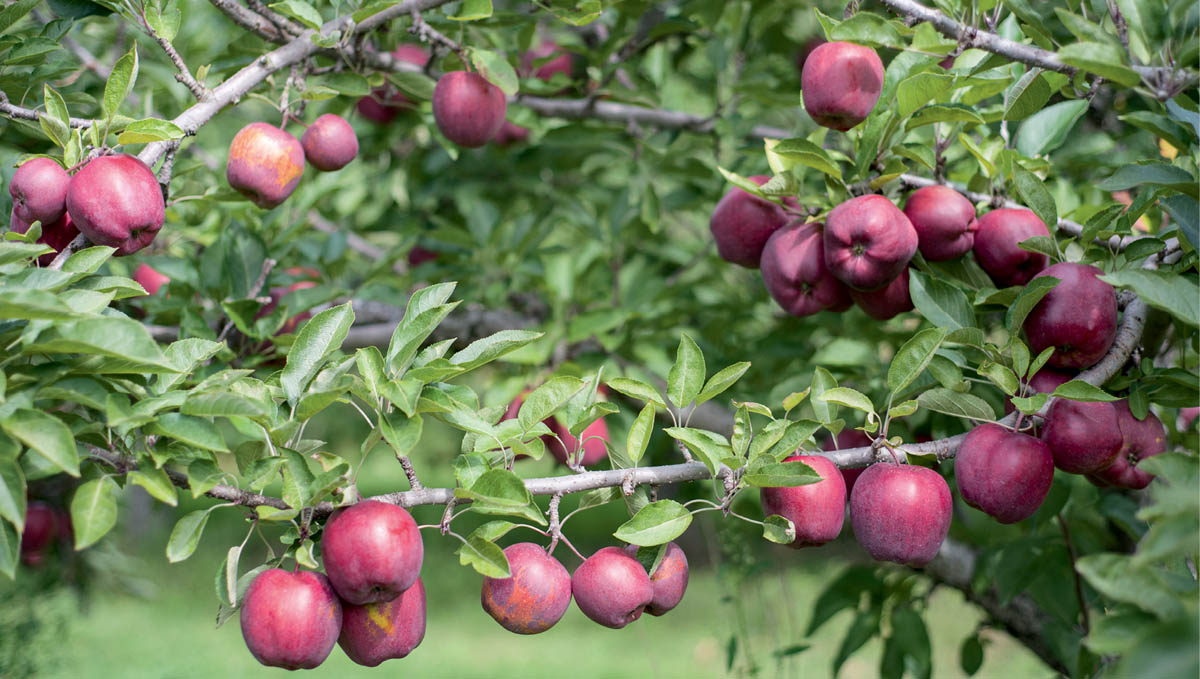
The decline in the selection of apple varieties can be traced to the end of the nineteenth century and the advent of commercial orchards. After World War II, the decline was hastened by the horticultural practice of mass planting only a few reliable varieties that met certain requirements, such as the ability to produce heavy crops, resist diseases, endure long-distance transportation, and last in long-term cold storage. Smooth, evenly colored skin and pleasing shape also factored into the equation. Other varieties were chosen because they were the best candidates for large-scale production of juice, sauce, and pie filling. While these qualities tip the scales in favor of popularity with commercial growers, they narrow the choice of varieties available to consumers, especially those who shop primarily in supermarkets.
Fortunately, apple breeders are always developing new varieties that have great growing qualities and taste delicious. Breeders develop new varieties by hybridizing (crossbreeding) two proven varieties.
During the past few decades, North America has witnessed an influx of new varieties. Some, such as Braeburn, Gala, Jazz, and Pink Lady, started out as imports from Australia and New Zealand. However, because they have many desirable qualities that appeal to both growers and consumers, they have been mass planted throughout the United States and many countries worldwide. Today, these newcomers are in full production in U.S. orchards.
While pomologists (apple breeders) are concerned primarily with developing hybrid varieties that are resistant to the major apple diseases (scab, fire blight, mildew, and cedar apple rust), quality attributes are also stressed.
A number of modern-day apple varieties are endowed with sweet-tart, juicy, crisp flesh. For example, Honeycrisp, a cross between Macoun and Honeygold developed at the University of Minnesota in 1960, has aromatic, honey-sweet, crisp flesh that maintains its outstanding texture and flavor during long-term storage. Jonagold, a cross between Jonathan and Golden Delicious, is also a high-ranking apple in U.S. taste tests. And the Pink Lady apple from Australia (where it was developed as Cripps Pink) has become a raving success in the United States and Europe. A cross of Golden Delicious and Lady Williams, this crisp, more-sweet-than-tart apple has become so incredibly popular that it has its own U.K. website.
The new apple varieties Lady Alice, Piñata, Autumn Crisp, SweeTango, and Zestar! are reaching the market in limited quantities but are being picked up by consumers with great enthusiasm.
Lady Alice. A chance seedling found in 1978 on a farm in Gleed, Washington, this medium-size round apple has tender skin flushed with pink and red over a yellow-orange background. The creamy, dense flesh is sweet-tart delicious and slow to brown, making it a good choice for salads, fruit trays, and eating out of hand. It is also a good all-purpose apple available out of long-term storage. Introduced to the consumer market in 2008, the Lady Alice apple is named in memory of Alice Zirkle, the cofounder of Rainier Fruit Company, the exclusive supplier of this incredible dessert apple. The Rainier Fruit Company has been growing fruit in the Northwest for over 100 years and is one of the largest growers of fresh apples, pears, cherries, and blueberries in the United States.
Piñata. German breeders successfully crossed Golden Delicious, Cox’s Orange Pippin, and Duchess of Oldenburg in the 1970s. When the hybrid apple was released in Europe in 1986, it was marketed under the names Pinova and Sonata. The rights to grow and market the Pinova cultivar in the United States were acquired by the Stemilt Growers in Washington State. Choosing a name to represent both Pinova and Sonata, they trademarked their apple as Piñata.
This large, orange-yellow apple is heavily flushed with red. The white flesh is crisp, juicy, and sweet-tart flavorful. Piñata is a superb all-purpose apple and does well in long-term storage.
Autumn Crisp. This is the 63rd apple released from the breeding program at the Cornell University Research Station in Geneva, New York. A cross between Golden Delicious and Monroe apples, Autumn Crisp has a higher vitamin C content than many other varieties. Its skin shows a yellow background blushed with red. The crisp, juicy white flesh is enticingly sweet-tart, a flavorful balance of sugar and acid that makes it a good all-purpose apple. Because the white flesh is slow to brown, it is a perfect candidate for salads and fruit plates and a delight to eat out of hand. It is available only in September through December.
SweeTango. Introduced in 2009, this apple is the offspring of the Minneiska cultivar developed by apple breeders at the University of Minnesota by crossing Honeycrisp and Zestar!. Like Zestar!, SweeTango is a registered trademark of the university and grown only as a “managed variety.” Growers must be licensed members of the Next Big Thing Cooperative and follow strict growing, harvesting, and shipping methods. So far, SweeTango is grown in Minnesota, Michigan, Washington, New York, and other northern states.
Harvested in late August and early September, SweeTango is available only for a few months through fall. However, the intensely crisp and crunchy flesh with sweet-tart spicy notes holds up longer under refrigeration. As with its parentage, the skin color of this apple has a yellow background deeply blushed with red. Already becoming a sought-after favorite, it is superbly delicious for eating fresh and can also be used for baking and cooking.
Zestar! Developed by University of Minnesota research scientists to withstand the harshest northern winters, Zestar!, the trademarked name of the patented Minnewashta cultivar, was introduced to consumers in 1999. Under Minnesota growing conditions, Zestar! apples ripen in late August to early September. However, unlike most early-season apples, they retain a crisp crunch to their zesty sweet-tart flesh for two months under refrigeration. This is a medium-size round apple with a creamy yellow background that is heavily blushed with rosy red.
One of the most promising trends in our ultramodern times is the return of interest in heirlooms, and particularly in those wonderful older varieties that got lost in the effort of mass production and distribution. (For information on specific heirloom varieties, see Hardy Heirloom Apple Varieties.)
More than 2,500 varieties of apples are grown at the New York State Agricultural Experiment Station in Geneva. One of the oldest agricultural research stations in the country, it is also the location for the U.S. Department of Agriculture’s Plant Genetic Resources Unit, which houses the national apple collection. The apple varieties range from historical varieties that originated in central Asia, to experimental hybrids from heirlooms that were brought as seeds, cuttings, or trees to America by European and English settlers, to the antique apples of North America that were grown from seeds in the eighteenth century.
Many of these heirloom or antique apples rank among the best varieties for eating out of hand and for making the most flavorful pies, applesauce, and apple juice. However, because of their unreliable yields, susceptibility to diseases, and misshapen fruits, few old varieties are grown in large commercial orchards.
In an effort to save important heirlooms that may contain unique genes, researchers at the Plant Genetic Resources Unit are always on the lookout for new genetic material. The reason has less to do with the fact that many of the heirlooms produce aromatic, intensely flavorful apples than with the fact that they represent genetic diversity. The key to safeguarding against the loss of genetic diversity is to rescue germplasm, the genetic material contained in the seeds.
Seeds collected in central Asia and planted in Geneva are now bearing fruits, ranging in color, form, and shape from purple and cherrylike to yellow, conical, and of commercial size. The diversity of the wild and heirloom varieties growing at the Plant Genetic Resources Unit provides researchers with the opportunity to develop new hybrids and cultivars that will be disease and pest resistant, winter hardy, vigorous, and highly productive, and will bear apples that are flavorful and firm.
While there is interest among apple growers in planting historical varieties on a commercial level, the economics discourage large-scale production. Even though heirloom varieties are available as dwarf and semidwarf trees, which bear quicker and more abundantly than their large, spreading ancestors, they still take longer to bear fruit than the apple varieties favored by large commercial orchards.
Heirloom varieties are grown by a limited number of farms, such as Breezy Hill Orchard in the Hudson Valley, New York, and Distillery Lane Ciderworks in Jefferson, Maryland. To buy heirloom varieties from these orchards, and from other antique-apple growers around the United States, you must contact the orchards directly or buy locally from specialty stores and farmers’ markets. You’ll find farmers’ markets in major towns and big cities.
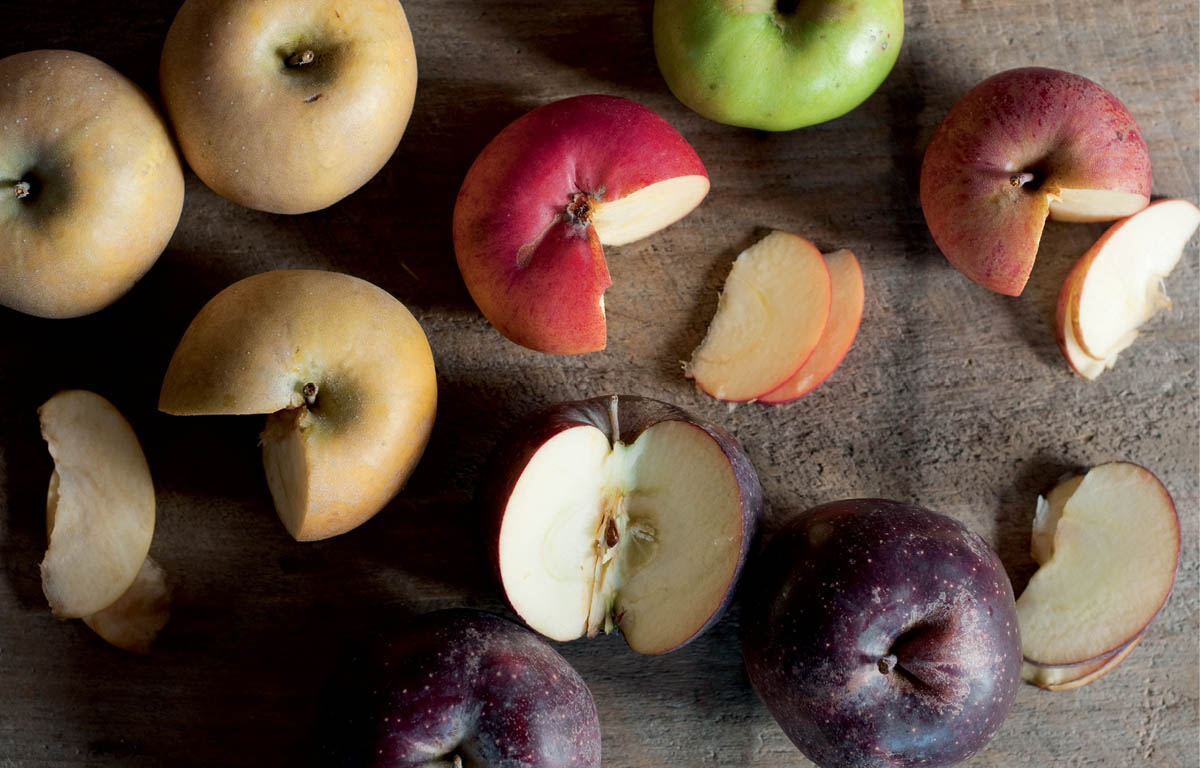
Cornell’s New York State Agricultural Experiment Station in Geneva is the major apple-breeding station in the United States. It was founded in 1880 to safeguard New York’s production of fruits and vegetables, develop new crops, improve food safety for consumers, and promote economically sustainable farming solutions. For more than 125 years, the station has been developing cutting-edge technologies essential to feeding the world and working to serve millions of consumers, agricultural producers, food businesses, and farm families throughout New York State. It is also, however, a state-of-the art research resource for homeowners, farmers, and researchers all over the world.
Also located at the New York State Agricultural Experiment Station in Geneva is another public resource — the largest apple collection in the world, called the National Apple Collection. Maintained by the Agricultural Research Service of the U.S. Department of Agriculture, it is home to thousands of varieties of apples, including varieties of M. sieversii, the main progenitor of the commercial apple. Collected from the wild apple forests of central Asia, they have a genetic resistance to diseases that can help apple breeders develop new resistant varieties and rootstocks.
Most of the varieties used for breeding new cultivars of apples in the United States come from what is known as the North America gene pool. Dating back to the seedling orchards planted when settlers first arrived between the seventeenth and nineteenth centuries, this collection is often referred to as the Johnny Appleseed gene pool.
Apples are available throughout the year in North America. Obviously, weather and latitude play a big part in the distribution of apple orchards across the United States. Varieties that ripen in September in the southern states ripen around November in the north. Because of differences in climate, an apple variety that is sweet and perfumed in Vermont may be flat and mealy in Virginia. In fact, in the north, some apples must be picked before they are mature in order to beat the first frost. Whatever the region, apples that are considered “best keepers” are left to ripen — often becoming sweeter and more flavorful with age — in controlled-atmosphere storage at larger commercial orchards.
Unfortunately, after December, the apples that reach consumers often have been transported long distances and may not have been kept under refrigeration in the grocery stores or supermarkets. Some stores may even polish their apples to make them look even more appealing, and this removes the natural bloom. Once this bloom is removed, apples start to break down.
At the orchards, the loads of just-picked apples are so fresh and in such peak condition they haven’t had time to bruise. It is for this reason that apple devotees go a little crazy every autumn. Starting as early as August and continuing through November, they make weekend pilgrimages to their local orchards and farm stands, looking for varieties that never reach the village markets or for those orchard jewels of limited production — such as Summer Rambo, Patricia, and Raritan.
When buying just enough apples for a pie, 21⁄2 pounds will do it — that’s about five large, seven to eight medium, or nine to ten small apples. A medium apple is approximately 3 inches in diameter.
A peck of apples weighs 101⁄2 pounds, and there are 42 pounds in a bushel. It’s cheaper to buy a bushel, but if you don’t plan to go on an immediate cooking spree (this quantity would make about 16 pies or 20 quarts of applesauce), make sure you can store them until you’re ready to use them, or that you have plenty of apple-loving friends.
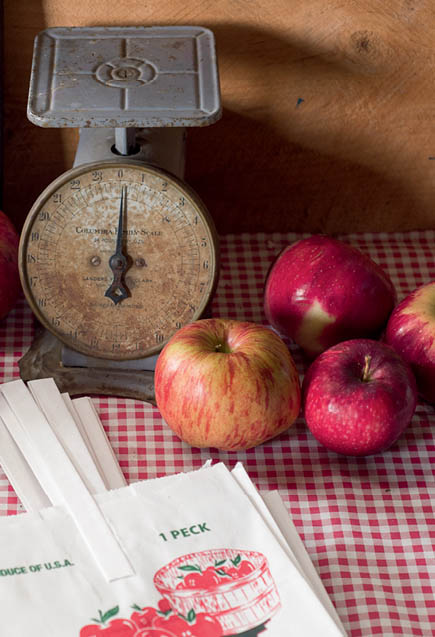
Although most apples are sold loose by the pound, quart, peck, or bushel, some retail stores sell them packaged in perforated plastic bags. The bags are stamped with the weight, variety, and U.S. grade — U.S. Extra Fancy, or U.S. Fancy, with U.S. No. 1 meeting the minimum standards of quality.
Apples are graded mostly according to color and size. A very large, deep-red Red Delicious will be Extra Fancy, while a small, somewhat greenish Red Delicious will be U.S. No. 1. I am frequently disappointed by large, perfect-looking apples. All too often they turn out to be tasteless and mealy.
Orchardists who sell locally grade their apples somewhat differently. Extra Fancy becomes Grade A, and Fancy is called Grade B, seconds, or utility. Grade B apples grow on the inside of the tree and are not as colorful or as large, and sometimes they are not as sweet. Windfalls or bruised apples are also called utility or Grade 3.
There’s nothing mystical about choosing apples. As a rule, what you see is what you get. If you bear the following points in mind, you’ll end up with some pretty good specimens in your bag:
Your decision to choose a particular variety should be influenced by what you plan to do with the apples. For the lunch box, you’ll want crisp, crunchy, juicy apples. Summer apples that have these qualities include Early Blaze, Ginger Gold, Jonamac, Patricia, Paula Red, and Raritan. Later, I would choose Braeburn, Empire, Fuji, Jonagold, Macoun, McIntosh, and Mutsu/Crispin, among others. If you want to bake apples whole, or make pies, then choose those that hold their shape and retain their flavor, such as Northern Spy, Stayman, Jonathan, Jonagold, Braeburn, and others. (See Apple Varieties and Their Best Uses for a complete breakdown.)
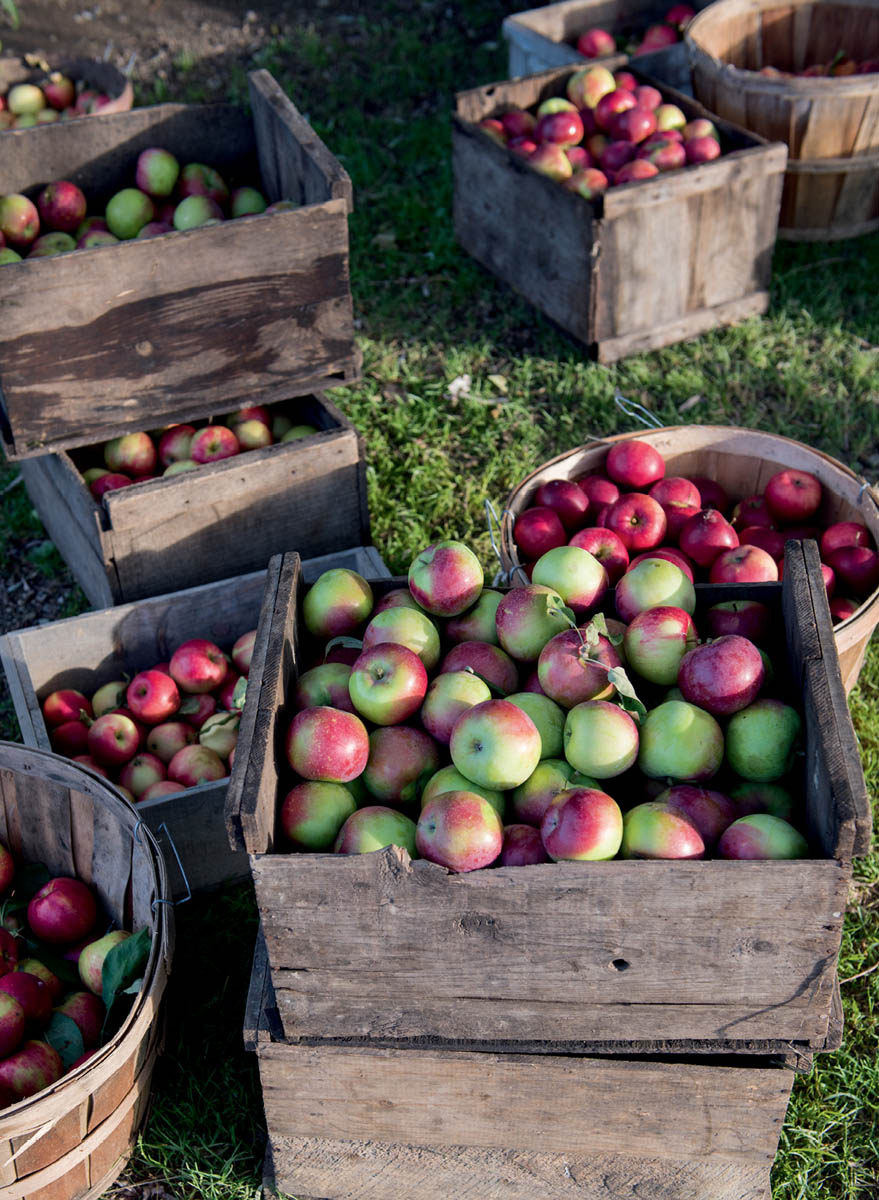
There’s a lot of goodness in the peel of an apple. It contains vitamin C, fiber, and much of the apple’s flavor. So why not leave the skin on for all the recipes? Because some apples have tough skins, and even if the skin is not tough when the apple is eaten raw, it does not break down in the cooking process. Nothing, in my opinion, spoils a fine cake, pudding, or applesauce more than finding some cooked apple skin. You can leave the apple skins on in any of the recipes that call for peeling. Then see how you feel about “to peel or not to peel.”
Planning to make gallons of applesauce? Then you may want to invest in a special strainer, available from specialty kitchen stores. For small batches of sauce, a food mill or a food processor does a fine job. I often purée my chunky skin-on applesauce in a food processor and barely notice the flecks of finely processed skin.
If a recipe calls for a lot of chopped or grated vegetables and apples, I use a food processor. When a recipe calls for cubed apples, I always prepare them by hand to make sure I get uniform pieces. A food processor will make very thin and very uniform apple slices in no time at all.
As famous as apples are for pie, they can be enjoyed in countless other ways. With just a little imagination, you can use this versatile fruit in almost as many savory recipes as dessert dishes.
Cut into rings, apples can be sautéed along with pork chops and cider. Chopped and sautéed with onions, they elevate such pedestrian fare as braised cabbage and Polish sausage from Sunday’s supper to a guest dish. When diced large, they make a delicious addition to any braised chicken recipe or pork and lamb stews. At some time or another, we’ve all had one of the many variations of apple stuffing with turkey and duck. Apple chutneys, relishes, and sauces can also take their place next to pork, poultry, goose, game, and curries.
For dessert, apples can be stuffed and baked, crisply frittered, folded into crêpes, mixed into cakes and breads, baked in tarts and pies, and tucked into cobblers and crisps.

“Baked” Whole 4 large apples, washed, cored, and scored around the center (this will prevent the apples from bursting). Arrange in a microwave-safe dish (stuff with dried fruit, nuts, honey, and butter as desired). Pour 1⁄2 cup apple juice or water into the dish, cover loosely with wax or parchment paper, and microwave on high for 10 minutes. Remove and let sit, covered, for 4 to 5 minutes, until tender.
Poached Slices 4 medium apples (about 1 pound), peeled, cored, and sliced 1⁄4 inch thick. Place in a microwave-safe dish. Dissolve 1⁄2 cup sugar in 1 cup hot water or apple juice and pour over the apple slices. Cover loosely with wax or parchment paper and microwave on high for 4 minutes, stirring after 2 minutes. Remove and let sit, covered, for 4 to 5 minutes, until tender.
Stewed 4 medium apples (about 1 pound), peeled, cored, and sliced 1⁄4 inch thick. Place in a microwave-safe dish and toss with 1⁄2 cup sugar and 1 tablespoon water. Cover loosely with wax or parchment paper and microwave on high for 8 minutes, stirring after 4 minutes. Remove and let sit, covered, for 2 to 4 minutes, until tender.
Sliced Wash or peel apples, cut in half, and remove cores. Place the desired medium or thick slicing disk into the food processor and lock the lid. Snugly stack the apples in the feed chute with cored sides facing the same way. Use the pulse button and gently press down the chute pusher to steadily feed the apples through the slicing disk. Repeat with the rest of the halved apples. After removing the slices, sprinkle with lemon or apple juice (or salad dressing) to prevent browning.
Chopped Wash or peel apples, halve, and core. Quarter and cut each into three chunks. Using the metal blade, drop no more than 2 cups of chunks at a time into the processor bowl. Lock on the lid and pulse about three times for a chunky chop and five or six times for a fine chop. Repeat with the rest of the apple chunks. Remove the chopped apples to a bowl and sprinkle with lemon or apple juice to prevent browning.
Apples ripen 10 times faster in a dry, warm atmosphere than when they are in cold storage. Therefore, commercial orchardists store their apples in controlled-atmosphere sealed chambers. Such storage reduces (without arresting) an apple’s intake of oxygen, which slows down its maturation process. This method prolongs the storage life of an apple by several months and enables orchardists to pick apples that are not meant for immediate consumption before they are fully ripe. As they mature slowly in controlled storage, the good keepers retain their juicy, crisp texture while becoming more flavorful and sweeter.
The U.S. Apple Association advises consumers to refrigerate apples in the hydrator drawer at temperatures anywhere from 32 to 40°F.
Some of the best apples for keeping include Cortland, Delicious, Empire, Fuji, Granny Smith, Honeycrisp, Idared, Macoun, McIntosh, Mutsu/Crispin, Northern Spy, Rhode Island Greening, Rome Beauty, Stayman, and Winesap.
Summer apples harvested in July, August, and early September are not good keepers. They must be refrigerated immediately and used within four to six weeks. These include the following varieties: Ginger Gold, Jerseymac, Jonamac, Lodi, Patricia, Paula Red, Puritan, Raritan, Summer Rambo, Tydeman’s Red, and Wellington.
When keeping your apples under refrigeration, be sure to store them in perforated plastic bags or containers to prevent them from drying out.
With some varieties, even short exposure to warm temperatures causes overripening, a mealy texture, and loss of flavor. So whether you pick your own apples or buy them in a store, put them into a cool place without delay. However, check first for damaged or bruised apples and set those aside for immediate use. As we all know, a rotten apple in the barrel surely does spoil the whole crop.
Besides refrigeration, other methods of preserving a bounteous harvest include freezing and canning slices and sauce and putting up preserves. See chapter 7 for more information on preserving.
I give apple variety recommendations in most of the recipes in this cookbook because some recipes work better with sweet apples, some with tart apples, and some with apples that have a hard texture and don’t fall apart. For example, in the Apple Puff Omelet, I specify two large Cortland, Jonathan, or Idared apples. Any of these would be my first choice because of their flavor and texture. However, if these varieties were not available, I would choose another that had similar qualities. In this case, I would choose Granny Smith apples that were very light green, an indication that they were ripe and only mildly tart (as opposed to dark green and very tart, qualities I would avoid unless I had no other choice and was desperate to make a pie). They also have a good firm texture. Failing that choice, I would then look for Golden Delicious, or Jonagold apples that were more green than yellow, an indication that they were barely ripe and had a firm texture and a more tart flavor than when completely yellow and fully ripe. In fact, my choice would be to combine the light green Granny Smith apples with other firm apples; the combination would provide a more complex flavor. If in doubt, refer to the discussion of apple varieties in chapter 8.
When a recipe calls for one large apple and yours look small to medium, substitute by the cup according to the Apple Equivalents table.